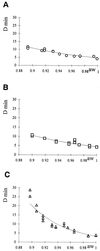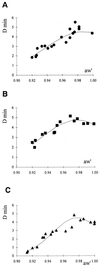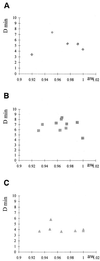Effect of water activities of heating and recovery media on apparent heat resistance of Bacillus cereus spores
- PMID: 11133461
- PMCID: PMC92574
- DOI: 10.1128/AEM.67.1.317-322.2001
Effect of water activities of heating and recovery media on apparent heat resistance of Bacillus cereus spores
Abstract
Spores of Bacillus cereus were heated and recovered in order to investigate the effect of water activity of media on the estimated heat resistance (i.e., the D value) of spores. The water activity (ranging from 0.9 to 1) of the heating medium was first successively controlled with three solutes (glycerol, glucose, and sucrose), while the water activity of the recovery medium was kept near 1. Reciprocally, the water activity of the heating medium was then kept at 1, while the water activity of the recovery medium was controlled from 0.9 to 1 with the same depressors. Lastly, in a third set of experiments, the heating medium and the recovery medium were adjusted to the same activity. As expected, added depressors caused an increase of the heat resistance of spores with a greater efficiency of sucrose with respect to glycerol and glucose. In contrast, when solutes were added to the recovery medium, under an optimal water activity close to 0.98, a decrease of water activity caused a decrease in the estimated D values. This effect was more pronounced when sucrose was used as a depressor instead of glycerol or glucose. When the heating and the recovery media were adjusted to the same water activity, a balancing effect was observed between the protective influence of the solutes during heat treatment and their negative effect during the recovery of injured cells, so that the overall effect of water activity was reduced, with an optimal value near 0.96. The difference between the efficiency of depressors was also less pronounced. It may then be concluded that the overall protective effect of a decrease in water activity is generally overestimated.
Figures





References
-
- Ababouch L F, Busta F F. Effect of the thermal treatment in oils on bacterial spores survival. J Appl Bacteriol. 1987;62:491–502. - PubMed
-
- Achard C, Gros J B, Dussap C G. Prédiction de l'activité de l'eau, des températures d'ébullition et de congélation de solutions aqueuses de sucre par un modèle UNIFAC. Ind Aliment Agric. 1992;109:93–101.
-
- Anagnastopoulos G D, Didhu H S. The effect of water activity and the aw controlling solute on spore germination of Bacillus stearothermophilus. J Appl Bacteriol. 1981;50:335–349.
-
- Baird-Parker A C, Boothroyd M, Jones E. The effect of water activity on the heat resistance of heat sensitive and heat resistant strains of salmonellae. J Appl Bacteriol. 1970;33:515–522. - PubMed
MeSH terms
Substances
LinkOut - more resources
Full Text Sources
Research Materials

